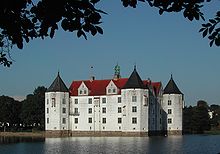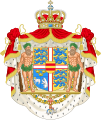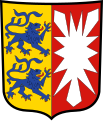House of Glücksburg
This article has multiple issues. Please help improve it or discuss these issues on the talk page. (Learn how and when to remove these messages)
No issues specified. Please specify issues, or remove this template. |
| House of Schleswig-Holstein-Sonderburg-Glücksburg | |
|---|---|
| Parent house | House of Oldenburg |
| Country | |
| Founded | 6 July 1825 |
| Founder | Friedrich Wilhelm |
| Current head | Christoph |
| Titles | |
| Estate(s) | Schleswig-Holstein & Glücksburg |


The House of Schleswig-Holstein-Sonderburg-Glücksburg (Template:Lang-da, the latter name is also spelled Glücksborg), known as the House of Glücksburg (or House of Glücksborg) for short, is a German ducal house, junior branches of which include the royal houses of Denmark and Norway, the deposed royal house of Greece, and the heir to the thrones of the Commonwealth realms[1][2] (although in the latter case, they are, by royal proclamation, declared to be members of the House of Windsor[3]). The family is named after Glücksburg in northernmost Germany, and is a cadet branch of the House of Oldenburg that is descended from King Christian I of Denmark. However, as the elder line of the House of Oldenburg and the line of the House of Schleswig-Holstein-Sonderburg-Augustenburg became extinct in 1863 and 1931, respectively, the House of Glücksburg is now the senior surviving branch of the House of Oldenburg.
This particular line comes from the Dukes of Schleswig-Holstein-Sonderburg-Beck. The last of them became Duke of Glücksburg and changed his title accordingly to Friedrich Wilhelm, Duke of Schleswig-Holstein-Sonderburg-Glücksburg. He was married to Princess Louise Caroline of Hesse-Kassel, a granddaughter of King Frederick V of Denmark.
Neither the Dukes of Beck nor of Glücksburg were sovereign rulers - they held their lands in fief to the sovereign dukes of Schleswig and Holstein (who were also the Kings of Denmark in personal union) and, before 1773, the Dukes of Holstein-Gottorp.
Christian IX of Denmark, the fourth son of Friedrich Wilhelm, was chosen by the childless King Frederick VII of Denmark to be his heir, as Christian was married to Frederick's first cousin, Luise of Hesse-Kassel. Wilhelm, the second son of Crown Prince Christian and Crown Princess Luise, was elected King of the Hellenes on March 30, 1863 to succeed the deposed Wittelsbach Otto of Greece and took the name George I of Greece. His father became King of Denmark as Christian IX on November 15, 1863. Prince Carl, the second son of Frederick VIII of Denmark, Christian IX's eldest son, became King of Norway on November 18, 1905 as Haakon VII of Norway. Christian IX's daughters, Alexandra of Denmark and Dagmar of Denmark (who became Maria Feodorovna), married Edward VII of the United Kingdom and Alexander III of Russia, respectively. As a result, by 1914, descendants of King Christian IX were more prevalent on European thrones than those of Queen Victoria 5-2; Christian IX became known as the Father-in-law of Europe.
Male line ancestry of Duke Friedrich Wilhelm
- Elimar I, Count of Oldenburg
- Elimar II, Count of Oldenburg
- Christian I, Count of Oldenburg (Christian the Quarrelsome)
- Maurice, Count of Oldenburg
- Christian II, Count of Oldenburg
- John I, Count of Oldenburg
- Christian III, Count of Oldenburg
- John II, Count of Oldenburg
- Conrad I, Count of Oldenburg
- Christian V, Count of Oldenburg
- Dietrich, Count of Oldenburg
- Christian I of Denmark
- Frederick I of Denmark
- Christian III of Denmark
- John II, Duke of Schleswig-Holstein-Sonderburg
- Alexander, Duke of Schleswig-Holstein-Sonderburg
- August Philipp, Duke of Schleswig-Holstein-Sonderburg-Beck
- Frederick Louis, Duke of Schleswig-Holstein-Sonderburg-Beck
- Peter August, Duke of Schleswig-Holstein-Sonderburg-Beck
- Karl Anton August, Prince of Schleswig-Holstein-Sonderburg-Beck
- Friedrich Karl Ludwig, Duke of Schleswig-Holstein-Sonderburg-Beck
- Friedrich Wilhelm, Duke of Schleswig-Holstein-Sonderburg-Glücksburg
Dukes of Schleswig-Holstein-Sonderburg-Glücksburg (1825–present)
Template:Schleswig-Holstein-Sonderburg-Glücksburg The Dukes of Schleswig-Holstein-Sonderburg-Glücksburg constitute the senior male line of the family, who hold the headship of both the House of Glücksburg and the entire House of Oldenburg.
- 1816–31 Friedrich Wilhelm, Duke of Schleswig-Holstein-Sonderburg-Glücksburg
- 1831–78 Karl, Duke of Schleswig-Holstein-Sonderburg-Glücksburg
- 1878–85 Friedrich, Duke of Schleswig-Holstein-Sonderburg-Glücksburg
- 1885–1934 Friedrich Ferdinand, Duke of Schleswig-Holstein-Sonderburg-Glücksburg, from 1931 Duke of Schleswig-Holstein
- 1934–65 Wilhelm Friedrich, Duke of Schleswig-Holstein
- 1965–80 Peter, Duke of Schleswig-Holstein
- 1980 – present Christoph, Duke of Schleswig-Holstein (b. 1949)
- Heir: Friedrich Ferdinand, Hereditary Prince of Schleswig-Holstein (b. 1985)
- Present line of succession
Junior branches
Junior branches of the House of Glücksburg are descended notably from Duke Friedrich Wilhelm's younger son, who became Christian IX of Denmark.
Monarchs of Denmark, 1863–present
The agnatic lineage is continued from Friedrich Wilhelm, Duke of Schleswig-Holstein-Sonderburg-Glücksburg.
- Christian IX of Denmark (1818–1906, reigned 1863–1906)
- Frederick VIII of Denmark (1843–1912, reigned 1906–12)
- Christian X of Denmark (1870–1947, reigned 1912–47), also king of Iceland 1918–1944
- Frederick IX of Denmark (1899–1972, reigned 1947–72)
- Margrethe II of Denmark (b. 1940, incumbent since 1972)
Kings of the Hellenes (Greece), 1863–1973
The Greek line is descended from Prince Vilhelm, a son of Prince Christian of Schleswig-Holstein-Sonderburg-Glücksburg (the later Christian IX of Denmark), who became King of the Hellenes as George I. The agnatic lineage is continued from Christian IX of Denmark.

- George I of Greece (1845–1913, reigned 1863–1913)
- Constantine I of Greece (1868–1923, reigned 1913–17, 1920–22)
- Alexander of Greece (1893–1920, reigned 1917–20)
- George II of Greece (1890–1947, reigned 1922–24, 1935–47)
- Paul of Greece (1901–1964, reigned 1947–64)
- Constantine II of Greece (b. 1940, reigned 1964–73)
- Present line of succession
Heirs to the Commonwealth realms and their ancestors
The heirs to the Commonwealth realms are descended from Prince Philip of Greece and Denmark, a paternal grandson of George I of Greece. However, by Letters Patent of 8 February 1960, Queen Elizabeth II declared that her children with Prince Philip would belong to the House of Windsor, as would any agnatic descendants who enjoy the style of Royal Highness, and the title of Prince or Princess. (Those who do not have that style and title would bear the surname Mountbatten-Windsor.)[3]
The agnatic lineage is continued from Friedrich Wilhelm, Duke of Schleswig-Holstein-Sonderburg-Glücksburg.
- Christian IX of Denmark
- George I of Greece
- Prince Andrew of Greece and Denmark
- Prince Philip of Greece and Denmark[2]
- Charles, Prince of Wales[2]
- Prince William, Duke of Cambridge[2]
Kings of Norway, 1905–present
The Norwegian branch is descended from Prince Carl of Glücksburg, a younger son of Frederick VIII of Denmark. He took the name Haakon as king.
- Haakon VII of Norway (1872–1957, reigned 1905–57)
- Olav V of Norway (1903–1991, reigned 1957–91)
- Harald V of Norway (b. 1937, incumbent since 1991)
- Heir: Crown Prince Haakon of Norway (b. 1973)
- Present line of succession
Other notable members
- Princess Ingeborg of Denmark (1878–1958). Daughter of Frederick VIII of Denmark, wife of Prince Carl, Duke of Västergötland, mother of Princess Margaretha of Sweden, Märtha of Sweden and Astrid of Sweden and Prince Carl, Duke of Östergötland (who themselves are not members of this house, but of that of Bernadotte).
- Princess Elena of Greece and Denmark (1896–1982). Wife of Carol II of Romania and mother of Michael I of Romania.
- Princess Olga of Greece and Denmark (1903–1997). Wife of the Regent Prince Paul of Yugoslavia.
- Princess Irene of Greece and Denmark, Duchess of Aosta (1904–1974). Wife of Aimone of Savoy, Duke of Spoleto.
- Princess Marina, Duchess of Kent (1906–1968). Wife of Prince George, Duke of Kent.
- Princess Cecilie of Greece and Denmark (1911–1937). Wife of Georg Donatus, Hereditary Grand Duke of Hesse and sister of Philip, later the Duke of Edinburgh. She died with her husband and two sons in the crash of Sabena Airlines Junkers JU52 (OO-AUB) at Ostend.
- Alexandra of Greece and Denmark (1921–1993). Wife of Peter II of Yugoslavia.
- Prince Philip, Duke of Edinburgh (b. 1921), grandson to George I of Greece, son to Prince Andrew of Greece, consort to Elizabeth II of the United Kingdom.
- Queen Sofia of Spain (b. 1938). Wife of King Juan Carlos I of Spain, sister of King Constantine II of Greece.
- Prince Michael of Greece and Denmark (b. 1939). Son of Prince Christopher of Greece and Denmark and Princess Françoise of Orléans (1902–1953); grandson of King George I of the Hellenes.
Heraldry
Note: the coat of arms of Norway is the coat of arms of Norway as a state, in use since the 11th century and used by all ruling houses since then, and not the family coat of arms of the House of Schleswig-Holstein-Sonderburg-Glücksburg.
References
- ^ Published on Saturday 18 April 2009 20:03 (2009-04-18). "Prince Philip beats the record for longest-serving consort - News - Scotsman.com". News.scotsman.com. Retrieved 2012-09-06.
{{cite web}}: CS1 maint: numeric names: authors list (link) - ^ a b c d Michel Huberty, L'Allemagne dynastique, Volume 7, Giraud, 1994, ISBN 2-901138-07-1, ISBN 978-2-901138-07-5
- ^ a b Francois Velde. "Royal Styles and Titles – 1960 Letters Patent". Heraldica.org. Retrieved 2012-09-06.





